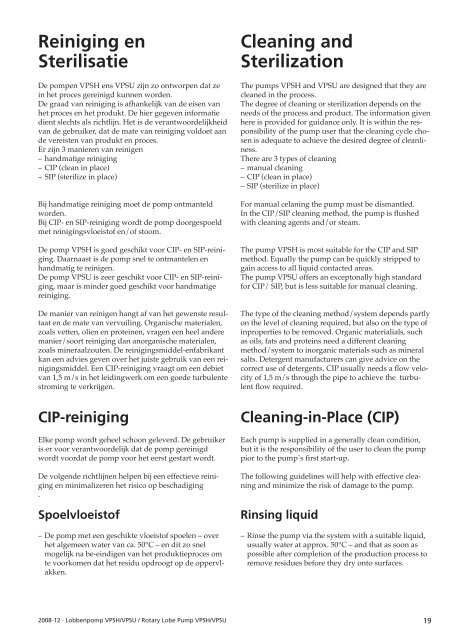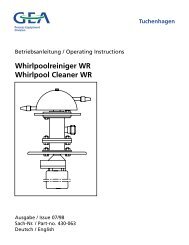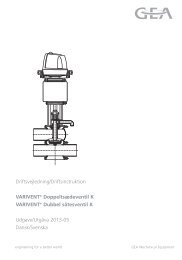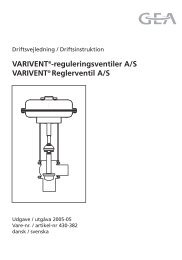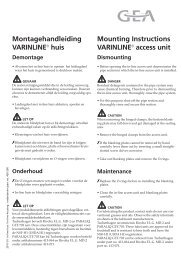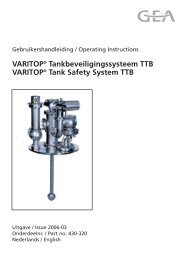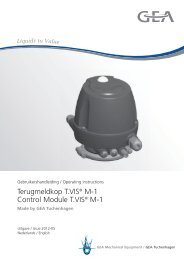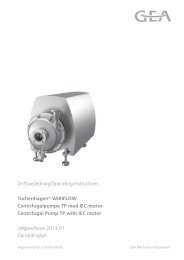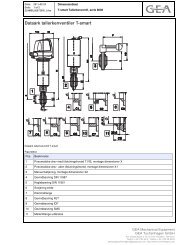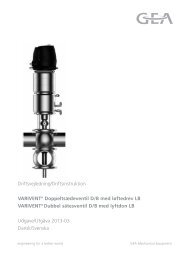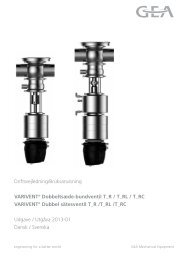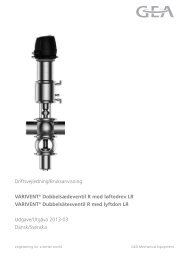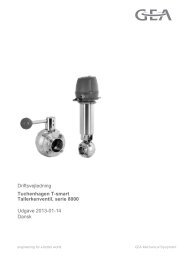Seals - ExtraNet - GEA Tuchenhagen
Seals - ExtraNet - GEA Tuchenhagen
Seals - ExtraNet - GEA Tuchenhagen
Create successful ePaper yourself
Turn your PDF publications into a flip-book with our unique Google optimized e-Paper software.
Reiniging en<br />
Sterilisatie<br />
De pompen VPSH ens VPSU zijn zo ontworpen dat ze<br />
in het proces gereinigd kunnen worden.<br />
De graad van reiniging is afhankelijk van de eisen van<br />
het proces en het produkt. De hier gegeven informatie<br />
dient slechts als richtlijn. Het is de verantwoordelijkheid<br />
van de gebruiker, dat de mate van reiniging voldoet aan<br />
de vereisten van produkt en proces.<br />
Er zijn 3 manieren van reinigen<br />
– handmatige reiniging<br />
– CIP (clean in place)<br />
– SIP (sterilize in place)<br />
Bij handmatige reiniging moet de pomp ontmanteld<br />
worden.<br />
Bij CIP- en SIP-reiniging wordt de pomp doorgespoeld<br />
met reinigingsvloeistof en/of stoom.<br />
De pomp VPSH is goed geschikt voor CIP- en SIP-reiniging.<br />
Daarnaast is de pomp snel te ontmantelen en<br />
handmatig te reinigen.<br />
De pomp VPSU is zeer geschikt voor CIP- en SIP-reiniging,<br />
maar is minder goed geschikt voor handmatige<br />
reiniging.<br />
De manier van reinigen hangt af van het gewenste resultaat<br />
en de mate van vervuiling. Organische materialen,<br />
zoals vetten, olien en proteinen, vragen een heel andere<br />
manier/soort reiniging dan anorganische materialen,<br />
zoals mineraalzouten. De reinigingsmiddel-enfabrikant<br />
kan een advies geven over het juiste gebruik van een reinigingsmiddel.<br />
Een CIP-reiniging vraagt om een debiet<br />
van 1,5 m/s in het leidingwerk om een goede turbulente<br />
stroming te verkrijgen.<br />
CIP-reiniging<br />
Elke pomp wordt geheel schoon geleverd. De gebruiker<br />
is er voor verantwoordelijk dat de pomp gereinigd<br />
wordt voordat de pomp voor het eerst gestart wordt.<br />
De volgende richtlijnen helpen bij een effectieve reiniging<br />
en minimalizeren het risico op beschadiging<br />
.<br />
Spoelvloeistof<br />
– De pomp met een geschikte vloeistof spoelen – over<br />
het algemeen water van ca. 50°C – en dit zo snel<br />
mogelijk na be-eindigen van het produktieproces om<br />
te voorkomen dat het residu opdroogt op de oppervlakken.<br />
2008-12 · Lobbenpomp VPSH/VPSU / Rotary Lobe Pump VPSH/VPSU<br />
Cleaning and<br />
Sterilization<br />
The pumps VPSH and VPSU are designed that they are<br />
cleaned in the process.<br />
The degree of cleaning or sterilization depends on the<br />
needs of the process and product. The information given<br />
here is provided for guidance only. It is within the responsibility<br />
of the pump user that the cleaning cycle chosen<br />
is adequate to achieve the desired degree of cleanliness.<br />
There are 3 types of cleaning<br />
– manual cleaning<br />
– CIP (clean in place)<br />
– SIP (sterilize in place)<br />
For manual celaning the pump must be dismantled.<br />
In the CIP/SIP cleaning method, the pump is flushed<br />
with cleaning agents and/or steam.<br />
The pump VPSH is most suitable for the CIP and SIP<br />
method. Equally the pump can be quickly stripped to<br />
gain access to all liquid contacted areas.<br />
The pump VPSU offers an exceptonally high standard<br />
for CIP/ SIP, but is less suitable for manual cleaning.<br />
The type of the cleaning method/system depends partly<br />
on the level of cleaning required, but also on the type of<br />
inproperties to be removed. Organic materialials, such<br />
as oils, fats and proteins need a different cleaning<br />
method/system to inorganic materials such as mineral<br />
salts. Detergent manufacturers can give advice on the<br />
correct use of detergents. CIP usually needs a flow velocity<br />
of 1,5 m/s through the pipe to achieve the turbulent<br />
flow required.<br />
Cleaning-in-Place (CIP)<br />
Each pump is supplied in a generally clean condition,<br />
but it is the responsibility of the user to clean the pump<br />
pior to the pump`s first start-up.<br />
The following guidelines will help with effective cleaning<br />
and minimize the risk of damage to the pump.<br />
Rinsing liquid<br />
– Rinse the pump via the system with a suitable liquid,<br />
usually water at approx. 50°C – and that as soon as<br />
possible after completion of the production process to<br />
remove residues before they dry onto surfaces.<br />
19


